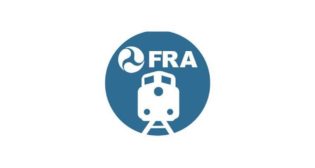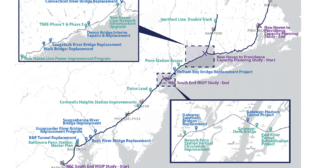
Oleksandr Kamyshin, Rail Force of One
Written by David Peter Alan, Contributing Editor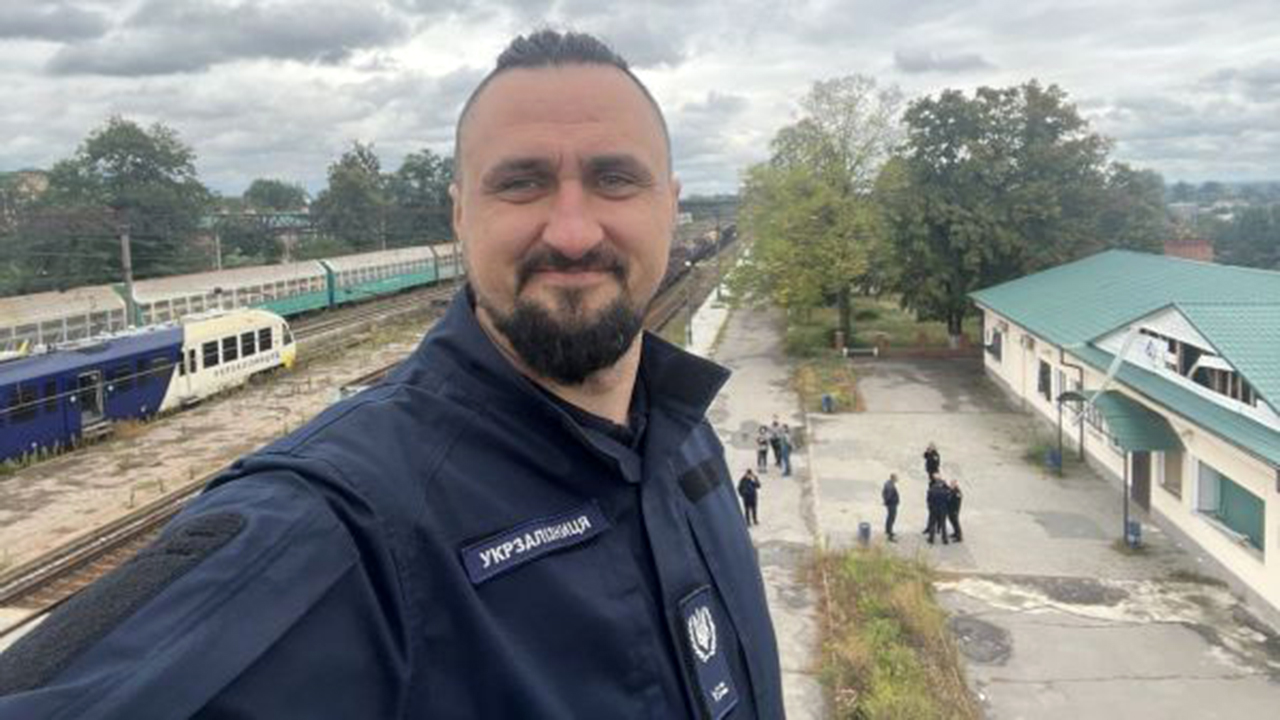
Alexander (Oleksandr) Kamyshin
Through two decades of writing about rail in publications of national scope, I have always concentrated on rail and transit news in the United States and Canada, leaving the international scene to reporters and commentators who occupy viewing and listening posts on the ground “over there.”
Still, there is an international story hiding in plain sight that deserves to be remembered, a story of transportation under fire, a story of diplomacy, a story of wartime service, and a story of a “railroad man” who quickly became an icon, not only because of the way he ran the railroad, but also because of the way he is boosting the reputation of railroading generally, despite the current furor about it here in the U.S.
He is Alexander (Oleksandr) Kamyshin, Ukraine’s recent Director General of Railroads. Since he took the post in 2021, and especially since Russian President Vladimir Putin sent troops to invade his nation, the railroad he led successfully carried hundreds of thousands of refugees across the country’s borders, brought some of them back as the country’s military scored successes later in the year, conducted many “diplomatic” trains for heads of state and other leaders, and considered it necessary to apologize for what he considered to be a substandard 90% level of on-time performance for scheduled service when ten trains were delayed. That happened when his passenger of honor was U.S. President Joe Biden. Now he’s moving on.
It came as a surprise when Kamyshin resigned his post as CEO of Ukrzaliznytsia (UZ), the Ukrainian rail system. David Burroughs reported on his departure for International Railway Journal (IRJ) on Feb. 28, quoting Kamyshin: “Leaving my position [with a] calm heart,” Kamyshin tweeted. “UZ keeps running, #iron_team doing [a] great job. Grateful to my President Zelenskyy and VPM [Vice Prime Minister Oleksandr] Kubrakov for high estimation of my performance.”
Kubrakov was not alone in praising Kamyshin, Burroughs reported: “Kamyshin has won praise and admiration from around the world for his leadership of UZ following the Russian invasion of Ukraine. The railway has proved a vital lifeline for the country, carrying refugees and grain out and bringing in vital supplies and equipment. The rail has also proved vital to Ukrainian diplomacy, safely carrying world leaders including U.S. President Joe Biden.”
Aleksandra Kittina, who had been a Deputy Minister in Ukraine’s Ministry of Infrastructure before becoming a journalist, reported on Kamyshin’s departure in the March 1 edition of the Kiev Post, the capital’s English-language paper: “Kamyshin proved himself to be an effective anti-crisis manager. Under his leadership, a corrupted and unreformed state-owned company became an effective evacuation vehicle that saved millions of lives in wartime.” Her report continued: “He turned a loss-making state company profitable, by making a decision unpopular among private business: to raise freight tariffs. Like many people in Ukraine, Kamyshin found his job was utterly transformed by Russia’s full-scale invasion of the country and the already complex task of trying to keep Ukraine’s trains running on time became a matter of life-and-death significance for millions. Yet despite the conflict, Ukraine’s trains did keep on running, and Kamyshin’s tweets often went viral—due to his dry humor, obsession with OTP (On Time Performance) and self-deprecating outpourings of disappointment over delays that had been caused by the most extraordinary of circumstances.”
Kittina’s story bore the headline “Ukraine’s Railway Chief (and Twitter Sensation) Has Resigned—Here Are Some of His Best Moments” and provided some highlights. On Dec. 17, 2022, he said, “War? Blackout? No Christmas tree? You’ll never guess what we invented:)))” and showed a video with his tweet that depicted a Christmas tree in Kyiv Central Station before the camera panned over to a man pumping the pedals of an exercise bicycle hooked up to a generator that powered the lights on the tree. On Nov. 6, he tweeted: “When #russians shell our energy infrastructure, we switch to diesel locos and #KeepRunning. We always have ‘plan b’. Was checking today ‘plan b’ for diesel locos—steam locos.” In the picture behind him stood a Soviet-style steam unit with a gold star at the head end of its tank. The steam unit that later pulled a special train for Christmas sported the Ukranian emblem instead of the Russian star. Throughout his tenure, Kamyshin also remained focused on on-time-performance. On Jan. 16, 2023, he tweeted: “Don’t want to be the most boring guy at the party, but yes, we had another best on-schedule day yesterday: 97% trains departed on time,96% trains arrived on time.”
Burroughs also reported for IRJ: “Kamyshin has also regularly used Twitter to provide updates on the work that is being undertaken to keep the UZ network operational, sharing harrowing stories of fellow workers who have been killed during the fighting.” When he unveiled a memorial to them as part of the observance of the first anniversary of the start of the war, Kamyshin mentioned that 353 railroad workers had been killed and another 819 injured, while 9874 more were serving in the armed forces.
“Iron Diplomacy” and “Rail Force One”
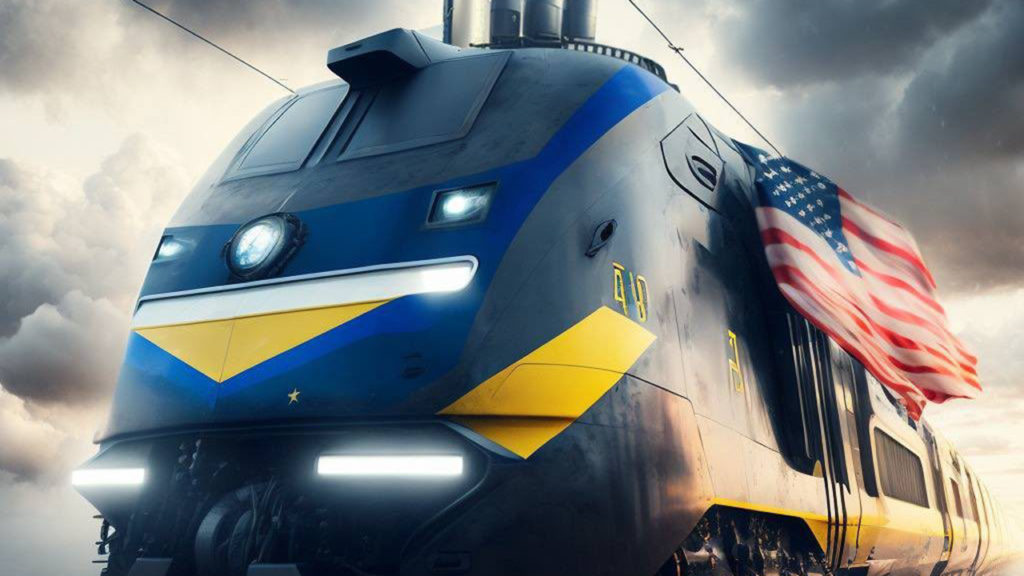
In late January, the Japan Times reported: A possible visit by Prime Minister Fumio Kishida is facing mounting challenges involving security and difficulty keeping the trip schedule and route a secret.” On Jan. 25, Kamishin tweeted: “We have successfully brought in and out more than 250 top rank official delegations from all over the world. Including the most demanding and complicated cases. Sure we’d successfully arrange a Japanese one as well. That’s how #IronDiplomacy works.” Former British Prime Minister Boris Johnson had visited Ukraine the same day, and Kamyshin related how Johnson had bought a Ukranian Railways hat and donated his old London Underground hat to the Ukrainians.
The biggest challenge came a month later. President Joe Biden visited Kyiv on February 20 to meet with President Zelenskyy and other officials. Reuters reported the trip and noted that Biden and his party started the segment to Kyiv in Poland and caught the train at the border town of Przemsyl. According to Reuters, “Biden then boarded a train and traveled 10 hours to Kyiv. By then it was Sunday night, and Biden’s train traveled in the dark with a heavy security presence on board. The train came to a stop at the Kyiv-Pasazhyrsky station in the Ukrainian capital at roughly 8 a.m. local time (0600 GMT) on Monday. The area around the platform had been cleared and the U.S. ambassador to Ukraine, Bridget Brink, awaited Biden and his staff.”
British paper The Guardian reported on Biden’s trip as part of its story headlined’Rail Force One’: How Ukrainian Railways got Joe Biden safely to Kyiv and reported on Feb. 24, the one-year anniversary of the Russian invasion. Kyiv reporter Peter Beaumont described Kamyshin and then described his security practices: “A handsome bearded man sporting a hipster-ish braid of hair that falls over the shaved sides of his head, Kamyshin is deliberately vague about many of the details. But in the past year, his dedicated team has brought in world leaders, VIPs and diplomatic missions on an almost daily basis as part of a programme called ‘Iron Diplomacy.’” Beaumont quoted Kamyshin on the topic of security: “We have not had one leak. There have been no photographs from train attendants. We respect the confidence of the delegations. It’s not a challenge. It’s our job that we do every day. Imagine the president of the United States coming to a war-torn country by train.”
Kamyshin posted his own series of tweets on Feb. 21 about Biden’s visit and the role of his railroad in taking Biden and his party to Kyiv. The simplest was “Let’s just say that Biden’s visit to Kyiv yesterday was a historic moment.” Probably the most inventive was when he dubbed the car in which Biden rode “Rail Force One,” a play on the President’s plane, Air Force One. He said “It was an honor and a privilege for me and the whole #IronTeam of #Ukrzailznytsia to deal with this visit. I must say, it was complicated. But we did it. That’s how #RailForceOne appeared.”
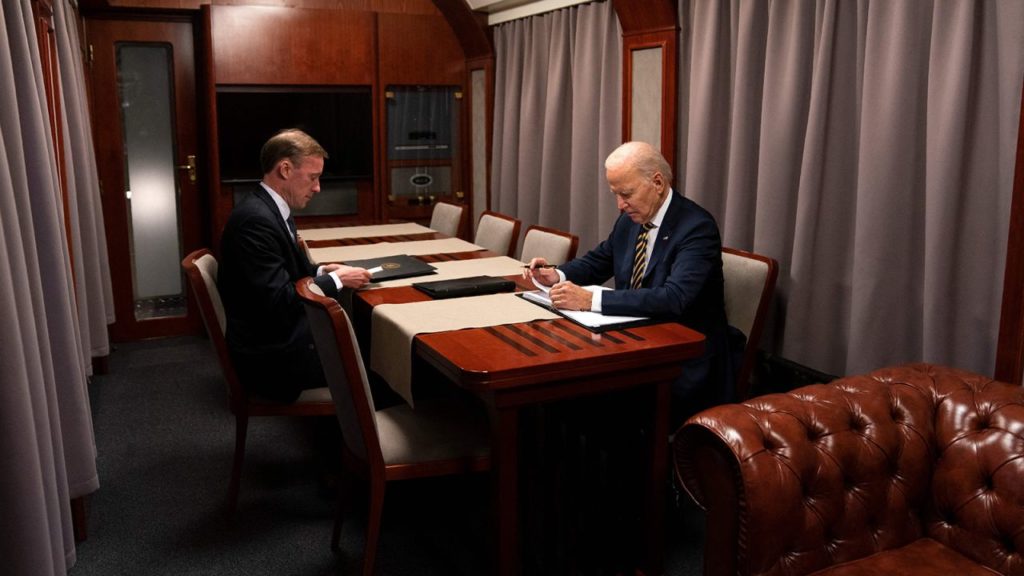
Referring to Biden himself, Kamyshin said: “Out of 24 hours, President Biden spent 20 on the train (both directions), and only 4 in Kyiv. That’s why it was important for us to care about him in a proper way. And we did.” He could not deliver a detailed summary of the trip, but said,“I will not tell much more about this mission. Just believe me it was quite a complicated project for us. Our #IronDiplomacy program helps my country withstand in this war, that’s why we #KeepRunning.” In other tweets, Kamyshin thanked other officials and the embassy team and, as we previously reported, apologized for what he considered poor OTP that day: “I also want to apologize for breaking our OTP (On Time Performance) yesterday. We had to delay some of our trains to give a way to #RailForceOne. It was painful for me and my team, but I had to do that. So only 90% of our trains arrived on time yesterday. I apologize.”
Some of the pictures that Kamyshin attached to his tweets have a “classic” look about them, the rendering of “Rail Force One” in its Ukrainian livery and flying the American flag seems to “say it all” about Biden’s visit to Ukraine and how he got to Kyiv. There is also a shot of Biden by himself, sitting at a conference table in an office car and reviewing a document. To this writer, if any pose highlighted the potential for reviving overnight trains to get to a destination and the potential but unrecognized use of trains for business travel in the years to come, that one did. Yet, in the U.S., Amtrak does not operate any trains on convenient overnight schedules for business travel between any city pairs. The sole exception might be the Night Owl (Trains 66 and 67), which lost its official name, but runs between Boston and Washington overnight. That will not be true for much longer, though, effective in early April, that train will not run north of New York on account of a project along the Hell Gate Bridge route.Will Biden call on Amtrak to run some? Time will tell.
A Career Chronicled in Tweets
Kamyshin tweeted regularly about what he and the railroad were doing, usually on the passenger side, but sometimes on the freight side. His output is preserved on Twitter’s web site, www.twitter.com. On Dec. 16, the day before he highlighted the Christmas tree at the Kiev station, he reported: “So. Another heavy shelling. Another blackout. Another heavy delays of our trains. But we cancel no single train. And all stations are illuminated. We know what to do to #keeprunning. But yes, #haterussians.” He later posted his #IronChristmas Ukrainian playlist on #Spotify.
The evening before his post about the tree in the station, he tweeted: Believe me, #IronPeople (his name for his country’s railroaders) know how to dance, too!” He attached a short video of uniformed employees dancing aboard a passenger car. He also understood the politics of railroading and the war when he said on Dec.14: “International Union of Railways @uic suspended the membership of the railways of #russia and #belarus. The resolution was approved at the General Assembly in Paris. China, India, Iran, Mongolia, Kazakhstan and Armenia voted against.” On corporate politics, he said on Dec. 19 that he voted for Elon Musk to step down as CEO of Twitter, complaining that “Twitter started hiding Ukrainian agenda.” He also demonstrated his loyalty to passenger trains when he commented on Dec. 21 on President Zelenskyy’s upcoming Washington trip to meet with President Biden and the U.S. Congress: “A bit nervous. First time since the beginning of the war my President goes for a trip not by train. Actually by train but also not by train. Forgot the name for that transport vehicle that flies. Nervous.”
Even as he ended his leadership on the railroad, Kamyshin was able to tweet about the stellar service that he and his team had provided: “Yesterday we got another best ever day for passenger trains OTP (on time performance): 96% trains departed on schedule, 99% trains arrived on schedule,” and he concluded by saying “I know I am boring, but this day was really good. #KeepRunning.”
He also tweeted about financial accomplishments for his railroad, and about equipment and parts on order. Before taking the top job at the rail agency, Kamyshin held accounting and financial positions, as well as degrees from the International University of Finance and Ukraine’s National Technical University, the Kyiv Polytechnic Institute. He also holds a masters’ level degree from the Ukrainian State University of Railway Transport, all according to Linkedin.
Burroughs summarized his career: “He began his career in 2006 as a auditor with KPMG, and in 2009 became CEO of KMZ Industries. Between 2012 and 2019 he was supervisory director or Portinvest and Lemtrans, the port and railway business of SCM Group, before becoming managing partner of Fortior Capital in 2020. He became acting chairman of UZ in August, 2021, and was appointed chairman on October 25, 2021.”
Year of Notable Accomplishments
Russian troops invaded his country four months later, and he swung into action. He and his railroaders moved the people who had to go somewhere, even if was out of the country to avoid danger or back in when they were ready to return. He re-opened long-closed lines to other counties like Romania and Poland. He called freight routes to other European countries to the north, south, and west “EU—Ukraine Solidarity Lines” with a map, tweeted on Jan. 7. Three days later, he reported on westward movement of freight from Ukraine, displaying a map. On the passenger side, Kamyshin’s railroad offered tickets to Ukrainian cities and towns that were still under Russian occupation, tickets that would become valid when those destinations were liberated. When Network Rail Scotland complained that a line was out of service, Kamyshin answered: “We’re dealing with a daily shelling of railway infrastructure. With the line damaged, we find a way how to fix it and #KeepRunning.” He added: “We’ll share more info once we throw the #russians our of #Ukraine.”
Wherever he went, Kamyshin was a global goodwill ambassador for trains, particularly passenger trains, whether he thought about it that way or not. He even promoted rail travel, regardless of the war. In his tweet on Dec. 29, he said: “Another night on the train tonight. I feel like at least half my nights this year were on the train. Those were good nights. #LoveSleeperTrains.” Earlier that day, he said: “Due to Russian missiles strikes and the air defenses work, some debris have fallen onto the railway tracks in Kyiv… So there might be a 1-2 minute delay—according to the Kyiv city express.”
Onward and Westward
Kamyshin said goodbye with a simple tweet, which said: “Signed resignation letter. Upon agreement with VPM @ OlKubarkov, moving to EU to open eurointegration office of UZ. Leaving my position with calm heart. UZ keeps running, iron_team doing great job. Grateful to my President Zelenskyy and VPM Kubrakov 4 high estimation of my performance.”
This is probably the time to speculate on what he can accomplish on the international scene. The Ukrainian nation is united in its determination to win the war, and in its expectation that the victory will be won. Kamyshin had opened some rail lines between Ukraine and other countries, a necessity for a country whose shipping remains imperiled by Russia’s threats to Ukraine’s shipping infrastructure from its presence in Crimea. Today, Ukraine needs rail links to other countries for shipping to and from other European locations to the west. If it wins the war, those links will come in handy both for freight and passenger rail use. A man like Kamyshin, with his knowledge of business and of the railroad, and with his operating experience gained under highly adverse conditions, is ideally suited to work with government and rail officials elsewhere in Europe to develop the ties, both literally and politically, that his country and its railroad need.
There is a lot to be done, not the least of which is to change most (if not all) of Ukraine’s rail lines from the 1,520 mm Russian gauge to the 1,435 mm standard gauge that is prevails elsewhere in Europe. That would be a major undertaking, but it would facilitate freight interchange and through-running of passenger trains between Ukraine and elsewhere in Europe.
At this writing, there were 483 tweets from other folks, congratulating Kamyshin on the job he had done. One was famous rail blogger Mark Smith, known as the Man in Seat 61 (his website is www.seat61.com). He said: “Good luck in the new job, Alexander—what you and your team has done has been remarkable. I hope our paths cross one day.”
That goes for me, too. Railway Age honors a “Railroader of the Year” who has performed on the North American rail scene with distinction. But in a nation where the skies are devoid of passenger airliners and the rail lines are truly the nation’s lifelines, Alexander Kamyshin has served with superlative distinction under the most adverse wartime conditions, when a determined enemy is making a best effort to destroy those lifelines, which he supervised, and his employees operated. By doing so, he gave the railroading profession a boost that nobody else has managed to give it since the airlines and automobile interests began fighting the railroads (especially passenger, but also including freight) during the middle years of the 20th century, to force them into submission. Now that Kamyshin has hosted President Biden, maybe he can share some of his hard-earned wisdom with other Americans who could benefit from it, including freight-carrying railroads, Amtrak, and the FRA.
In case Biden doesn’t share the news, Kamyshin sent his own tweet to Amtrak on Jan. 11, after the FAA grounded U.S. airlines temporarily: “Hey, @Amtrak! Looks like you’ve got a chance to show what railways can do when planes don’t fly. Don’t let railways’ name down! I watch you! #Keep Running!”
That goes for me, too! To the Ukrainian Railroads: #KeepRunning and Slava Ukraini!
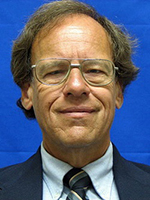
David Peter Alan is one of America’s most experienced transit users and advocates, having ridden every rail transit line in the U.S., and most Canadian systems. He has also ridden the entire Amtrak network and most of the routes on VIA Rail. His advocacy on the national scene focuses on the Rail Users’ Network (RUN), where he has been a Board member since 2005. Locally in New Jersey, he served as Chair of the Lackawanna Coalition for 21 years, and remains a member. He is also a member of NJ Transit’s Senior Citizens and Disabled Residents Transportation Advisory Committee (SCDRTAC). When not writing or traveling, he practices law in the fields of Intellectual Property (Patents, Trademarks and Copyright) and business law. The opinions expressed here are his own.

